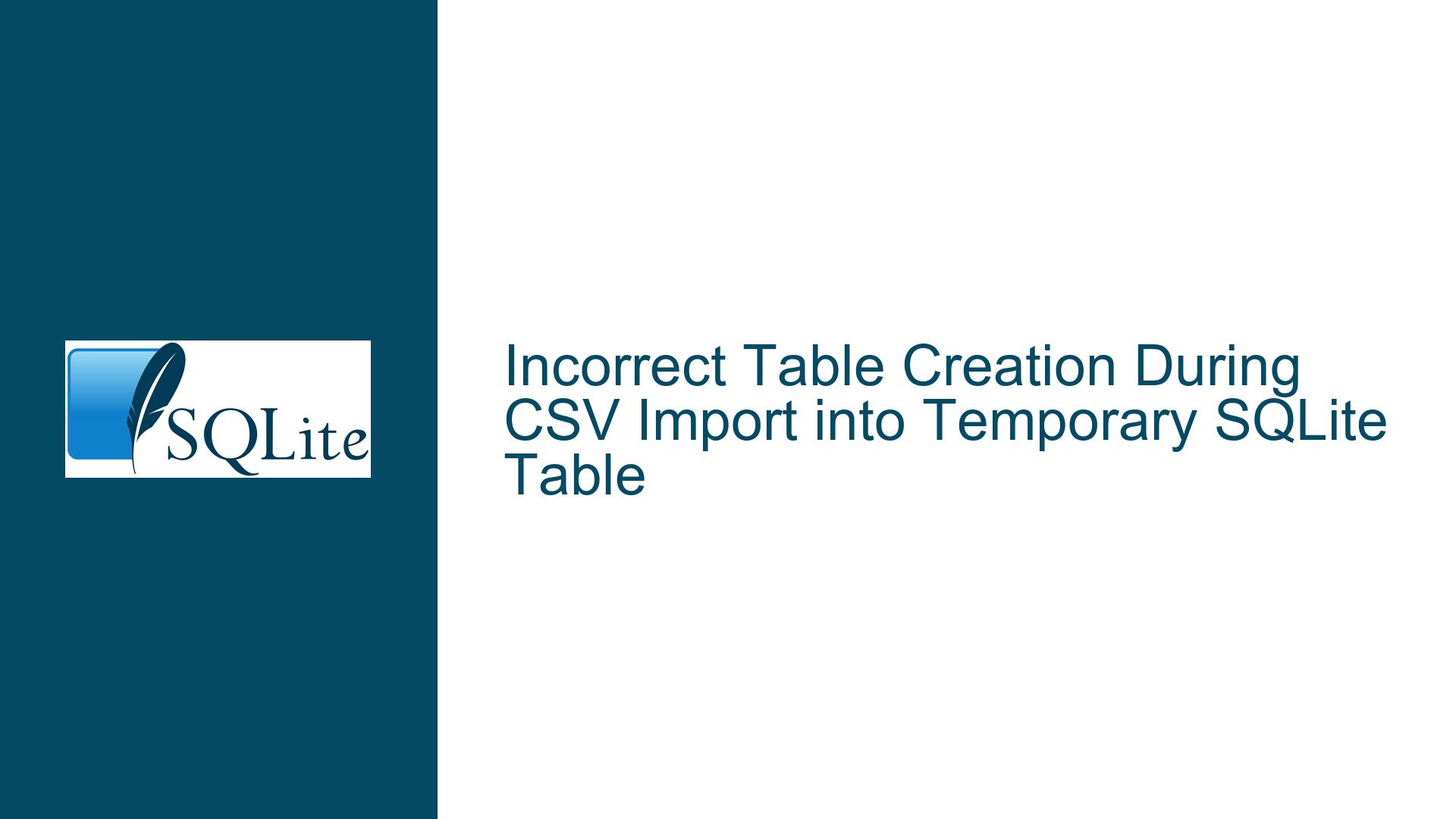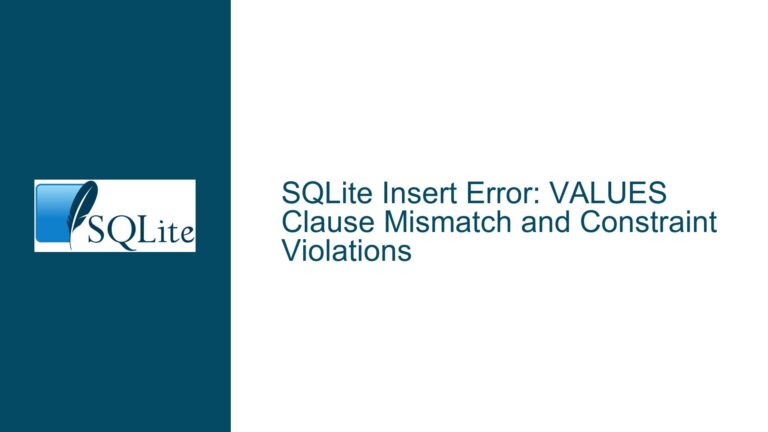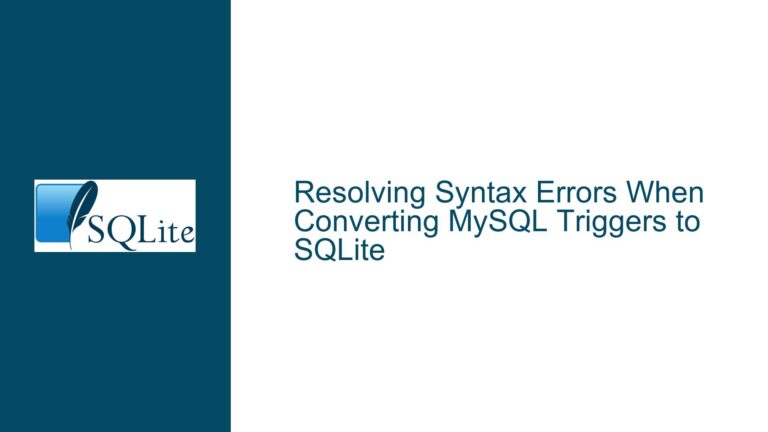Incorrect Table Creation During CSV Import into Temporary SQLite Table
Issue Overview: Misinterpretation of .import Command Schema Specification Leading to Erroneous Table Creation
When attempting to import CSV data into a pre-existing temporary table using SQLite’s command-line interface (CLI), users may encounter unexpected behavior where multiple tables are created instead of data being inserted into the target table. The core problem revolves around three interconnected phenomena:
Schema Qualification in .import Command Misparsing
The SQLite CLI’s.importcommand does not natively support schema-qualified table names (e.g.,temp.files). When users specifytemp.filesas the target table, the CLI interprets the entire stringtemp.filesas a literal table name in the main schema, not as a table namedfilesin thetempschema. This results in a new permanent tabletemp.filesbeing created in the main database if no such table exists elsewhere.Virtual Table Auxiliary Artifacts
When using Full-Text Search (FTS5) virtual tables, SQLite automatically generates auxiliary tables (e.g.,*_content,*_config,*_idx). These are created alongside the virtual table itself. If the target table name is misinterpreted (as in #1), these auxiliary tables compound confusion by appearing as additional "empty" tables.Version-Specific Behavioral Regressions
Between SQLite 3.37.2 and 3.38.0, changes to.import‘s schema handling introduced unintended persistence of temporary tables. A temporary table created during import would erroneously become part of the main database schema, violating SQLite’s transaction isolation principles.
The convergence of these factors leads to scenarios where:
- A permanent table
temp.filesis created in the main schema - FTS5 virtual table auxiliary structures appear as empty tables
- Legacy scripts relying on temporary table isolation break after version updates
Possible Causes: Schema Ambiguity, CLI Command Limitations, and Version-Specific Bugs
1. Schema Qualification Syntax Misapplication
The .import command’s syntax (.import FILE TABLE) does not accept schema prefixes like temp. or main.. This limitation stems from historical design decisions where the CLI prioritizes simplicity over SQL language completeness. When users specify temp.files as the TABLE parameter, the CLI parses this as a single identifier, not a schema-qualified name. SQLite’s identifier parsing rules allow periods in table names, so temp.files becomes a valid (if unusual) table name in the main schema.
Example of Misinterpretation
.import data.csv temp.files -- Creates table [temp.files] in main schema
vs
CREATE TABLE temp.files(...) -- Creates table [files] in temp schema
2. FTS5 Virtual Table Side Effects
FTS5 virtual tables automatically generate shadow tables for indexing and configuration. If the target table name is misconfigured (e.g., temp.files instead of files in the temp schema), these auxiliary tables adopt the misinterpreted name as their root:
temp.files -- Virtual table (if properly created)
temp.files_content -- Auxiliary table
temp.files_idx -- Auxiliary table
...
When the virtual table is improperly created in the main schema (due to .import syntax issues), these auxiliary tables become permanent fixtures, further obfuscating the problem.
3. .import Command Logic Flaws
Prior to SQLite 3.38.0, the .import command would create tables in the temp schema if they did not exist elsewhere. However, post-3.38.0, a regression caused temporary tables created during import to be persisted to the main schema. This violated the principle that temporary tables should exist only for the duration of the database connection.
Regression Example
-- SQLite 3.37.2
.import data.csv temp_table -- Creates temp_table in temp schema (volatile)
-- SQLite 3.38.0 (bug)
.import data.csv temp_table -- Creates temp_table in main schema (persistent)
Troubleshooting Steps, Solutions & Fixes: Schema Validation, CLI Workarounds, and Version-Specific Corrections
1. Correct Schema and Table Initialization
Step 1: Pre-Create the Temporary Table
Explicitly create the temporary table before importing, ensuring it resides in the correct schema:
CREATE TEMP TABLE files(file TEXT); -- Schema-qualified temp table
.import files.csv files -- Target table name without schema prefix
Step 2: Verify Table Creation
Use .tables with schema filters to confirm table existence:
.tables temp.* -- Lists all tables in temp schema
.tables main.* -- Lists all tables in main schema
Step 3: Avoid FTS5 for Simple Imports
If full-text search isn’t required, use standard tables:
CREATE TEMP TABLE files(file TEXT); -- Instead of FTS5 virtual table
2. .import Command Syntax Adjustments
Workaround 1: Omit Schema Qualification
When using .import, specify only the table name, relying on pre-creation to define the schema:
CREATE TEMP TABLE target(data TEXT);
.import data.csv target -- Imports into temp.target
Workaround 2: Use Schema-Aware CLI Options (SQLite ≥3.38.1)
Post-regression fixes, use the --schema option to explicitly define the target schema:
.import --schema temp data.csv files -- Imports into temp.files
Workaround 3: Patch Legacy CLI Versions
For SQLite 3.36.0–3.38.0, apply the community-developed patch to enable --temp flag:
/* Modified .import logic snippet */
if (useTemp) {
zCreate = sqlite3_mprintf("CREATE TEMP TABLE \"%w\"", zTable);
} else {
zCreate = sqlite3_mprintf("CREATE TABLE \"%w\"", zTable);
}
3. Addressing Version-Specific Regressions
Step 1: Check SQLite Version
sqlite3 --version
Step 2: Upgrade to 3.38.1 or Later
Regression fixes include:
- Proper isolation of temporary tables during
.import - Restoration of
--skipfunctionality with schema-qualified imports
Step 3: Downgrade to 3.37.2 if Immediate Upgrade Isn’t Feasible
Temporarily revert to pre-regression behavior while awaiting patch deployment.
4. Advanced Diagnostics with Hidden Schema Artifacts
Inspect SQLite Master Table
Query the sqlite_master table to identify miscreated tables:
SELECT name, sql FROM sqlite_master WHERE type='table';
Identify Auxiliary FTS5 Tables
Filter for FTS5 artifacts using:
SELECT name FROM sqlite_master WHERE name LIKE '%_content' OR name LIKE '%_config';
Cleanup Orphaned Tables
Drop erroneously created tables:
DROP TABLE IF EXISTS "temp.files"; -- Main schema table
DROP TABLE IF EXISTS "temp.files_content"; -- FTS5 artifact
5. Programmatic Alternatives to CLI .import
Use SQLite’s CSV Virtual Table
Bypass .import entirely using the CSV virtual table extension:
.load /usr/lib/sqlite3/csv.so
CREATE VIRTUAL TABLE temp.csv_data USING csv(filename='data.csv');
SELECT * FROM temp.csv_data;
Leverage Prepared Statements
Manually parse CSV data with SQL:
CREATE TEMP TABLE data(line TEXT);
.import data.csv data
INSERT INTO target_table SELECT TRIM(line) FROM data;
DROP TABLE data;
6. Behavioral Validation Tests
Test Case 1: Temporary Table Integrity
sqlite3 :memory: \
"CREATE TEMP TABLE t(x);" \
".import data.csv t" \
".tables"
# Should list only 't' in temp schema
Test Case 2: Schema Prefix Handling
sqlite3 test.db \
"CREATE TEMP TABLE target(x);" \
".import data.csv target" \
"SELECT * FROM temp.target;" # Should return imported data
Test Case 3: Post-Import Persistence Check
sqlite3 test.db ".import data.csv temp_data"
sqlite3 test.db "SELECT * FROM temp_data;" # Should fail if temp schema is volatile
By systematically applying these diagnostics and corrections, users can resolve table creation anomalies, ensure proper schema targeting, and mitigate version-specific regressions. The key lies in rigorous schema validation, adherence to .import syntax constraints, and proactive version management.






